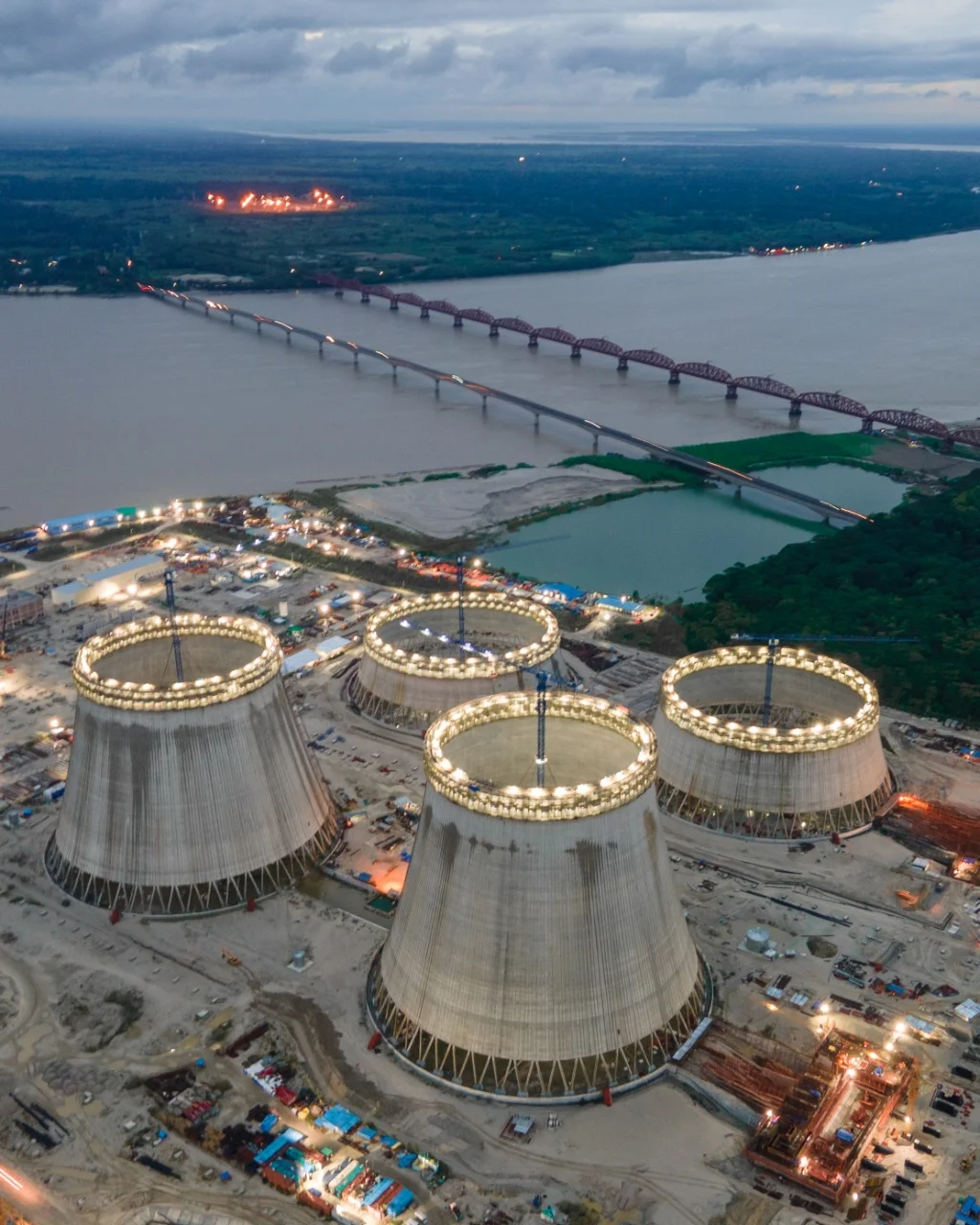Introduction
Bangladesh is entering a new chapter in its energy journey with the development of the Rooppur Nuclear Power Plant (RNPP), the first nuclear facility in the country. Positioned along the banks of the Padma River in the Pabna District, this ambitious project symbolizes Bangladesh’s strategic move to diversify its energy sources, address the growing demand for electricity, and reduce its reliance on fossil fuels. As global concerns about climate change and sustainable energy solutions intensify, the RNPP stands out as a landmark initiative aimed at providing a cleaner, more efficient power source for the nation’s future.
This article provides an in-depth exploration of the Rooppur Nuclear Power Plant, examining its development, the technology behind its construction, its economic and environmental benefits, and the challenges it faces. This comprehensive analysis is tailored for energy professionals, environmentalists, and curious minds eager to understand how nuclear energy can shape Bangladesh’s energy landscape.
The Vision Behind Rooppur Nuclear Power Plant
Historical Context and Development Goals
The concept of utilizing nuclear energy in Bangladesh originated in the 1960s, but it gained serious momentum only in the past decade due to the country’s expanding energy needs. The government of Bangladesh recognized the necessity to transition from traditional energy sources to more sustainable alternatives, setting the stage for the RNPP’s inception. The plant is intended not just to meet the immediate energy demands but also to provide a long-term, stable supply of electricity to fuel economic growth and industrialization.
Strategic Partnerships and International Support
To make the RNPP a reality, Bangladesh has partnered with Russia, leveraging their extensive expertise in nuclear technology. In 2011, an agreement was signed with Rosatom, the Russian state nuclear corporation, to construct two VVER-1200 reactors. This collaboration has been crucial in bringing advanced nuclear technology to Bangladesh, ensuring the plant is equipped with the latest safety features and meets international standards. The cooperation extends beyond construction, including operational support, fuel supply, and waste management services.
Understanding the Nuclear Technology at Rooppur
Features of VVER-1200 Reactors
The VVER-1200 reactors being installed at Rooppur represent some of the most advanced nuclear technology available today. These reactors utilize a pressurized water system that is designed to operate safely and efficiently under various conditions. They are equipped with innovative safety mechanisms, including a passive core cooling system and a core catcher, which enhance their ability to contain radioactive material in the unlikely event of an accident. These technological advancements not only improve safety but also optimize performance, allowing for higher output and reduced operational costs.
Commitment to Safety and International Best Practices
Ensuring the safety of the Rooppur Nuclear Power Plant is paramount to its success. Bangladesh has adopted a stringent regulatory framework overseen by the Bangladesh Atomic Energy Regulatory Authority (BAERA) to ensure the plant’s operations are in line with international nuclear safety standards. The plant’s design incorporates multiple redundant safety systems to prevent and mitigate any potential incidents. Regular safety drills, rigorous inspections, and continuous monitoring are part of the operational protocols to maintain a high safety standard.
Environmental Considerations and Waste Management
Environmental sustainability is a key consideration in the development of the RNPP. The plant is designed to have minimal environmental impact, utilizing advanced technology to manage waste and prevent radiation leakage. Spent nuclear fuel is stored securely on-site in specially designed facilities until it can be safely transported for reprocessing or disposal. Additionally, the RNPP incorporates several layers of environmental protection, including air and water monitoring systems to ensure that the surrounding ecosystem remains unaffected.
The Economic Impact of the Rooppur Nuclear Power Plant
Economic Benefits and Industrial Growth
The construction and future operation of the RNPP are expected to have significant positive economic effects on Bangladesh. The project has already generated thousands of jobs in construction, engineering, and support services, providing a boost to the local economy. In the long term, the availability of a reliable and cost-effective energy source is expected to attract further industrial investment, particularly in energy-intensive sectors such as manufacturing and technology. This influx of investment could drive broader economic growth and development across the country.
Enhancing Energy Security and Reducing Dependency
One of the key motivations behind the RNPP is to enhance Bangladesh’s energy security by reducing its dependence on imported fossil fuels. With the two reactors capable of generating a combined 2,400 MW of electricity, the plant will significantly contribute to the national grid, providing a stable and continuous power supply. This capability is particularly important for Bangladesh, which has traditionally relied on natural gas and imported coal to meet its energy needs. By diversifying its energy mix, Bangladesh aims to reduce vulnerability to global energy price fluctuations and improve energy independence.
Societal Benefits: Education and Innovation
The RNPP has also created opportunities for education and innovation within Bangladesh. In collaboration with international partners, local universities have introduced nuclear science and engineering programs to develop the next generation of nuclear experts. These initiatives not only build a skilled workforce for the nuclear sector but also foster a culture of scientific inquiry and technological innovation. The knowledge and expertise gained from the RNPP project could potentially be applied to other sectors, driving broader scientific and technological advancements in Bangladesh.
Navigating Challenges and Looking Ahead
Financial and Logistical Challenges
Despite the many potential benefits, the development of the Rooppur Nuclear Power Plant is not without its challenges. The project has faced financial hurdles, including cost overruns and delays, which are common in large infrastructure projects. Securing ongoing funding and managing costs remain key priorities for the government and its partners. Additionally, logistical challenges, such as transporting materials and ensuring the timely delivery of components, have required careful planning and coordination.
Building Public Trust and Addressing Concerns
Public acceptance is crucial for the success of any nuclear project. In Bangladesh, there have been concerns about the safety of nuclear energy and its potential environmental impacts. To address these issues, the government has prioritized transparency and community engagement, providing regular updates on the project’s progress and implementing educational programs to inform the public about the benefits and safety measures of nuclear energy. These efforts aim to build trust and gain broader support for the RNPP and future nuclear initiatives.
Future Expansion and Regional Collaboration
The successful implementation of the RNPP could open the door to further nuclear developments in Bangladesh. As the country gains experience in managing nuclear technology, there may be opportunities to expand its nuclear capabilities or collaborate with neighboring countries on regional energy projects. Such collaboration could enhance regional energy security, foster economic integration, and promote sustainable development across South Asia.
Conclusion
The Rooppur Nuclear Power Plant represents a bold step forward for Bangladesh as it seeks to secure a sustainable energy future. By harnessing the power of nuclear energy, Bangladesh is positioning itself to meet its growing energy demands, reduce greenhouse gas emissions, and drive economic development. While challenges remain, the RNPP stands as a testament to what can be achieved through international collaboration, strategic planning, and a commitment to safety and innovation.
Call to Action:
Stay informed about the progress of the Rooppur Nuclear Power Plant and its role in shaping Bangladesh’s energy future. Join the discussion on sustainable energy solutions and contribute to building a more resilient and energy-secure future for all.





